Carbon Composite Bipolar Plates Market Size 2025-2029
The carbon composite bipolar plates market size is valued to increase by USD 100.1 million, at a CAGR of 8% from 2024 to 2029. Escalating adoption of fuel cell electric vehicles will drive the carbon composite bipolar plates market.
Major Market Trends & Insights
- APAC dominated the market and accounted for a 53% growth during the forecast period.
- By Type - CBPC segment was valued at USD 149.40 million in 2023
- By End-user - Automotive segment accounted for the largest market revenue share in 2023
Market Size & Forecast
- Market Opportunities: USD 90.54 million
- Market Future Opportunities: USD 100.10 million
- CAGR from 2024 to 2029 : 8%
Market Summary
- The market experiences significant growth, fueled by the increasing demand for fuel cell electric vehicles and the intensifying global hydrogen economy push. Carbon composite bipolar plates, a critical component in fuel cells, facilitate the efficient transfer of ions and electrons between the electrodes. According to a recent study, the market value for carbon composite bipolar plates is projected to reach USD1.2 billion by 2026, underscoring their increasing importance. Despite this promising outlook, challenges persist. High manufacturing costs and the lack of scalability pose significant hurdles. Nevertheless, researchers and manufacturers continue to innovate, exploring advanced manufacturing techniques and alternative materials to address these issues.
- The integration of nanotechnology and 3D printing in the production process is expected to bring down costs and increase efficiency. Additionally, the development of lightweight, high-performance carbon composite materials is a promising avenue for improving scalability. In summary, the market is poised for substantial growth, driven by the expanding adoption of fuel cell electric vehicles and the global hydrogen economy push. Despite challenges, advancements in manufacturing techniques and materials offer potential solutions to overcome obstacles, ensuring the market's continued evolution and growth.
What will be the Size of the Carbon Composite Bipolar Plates Market during the forecast period?
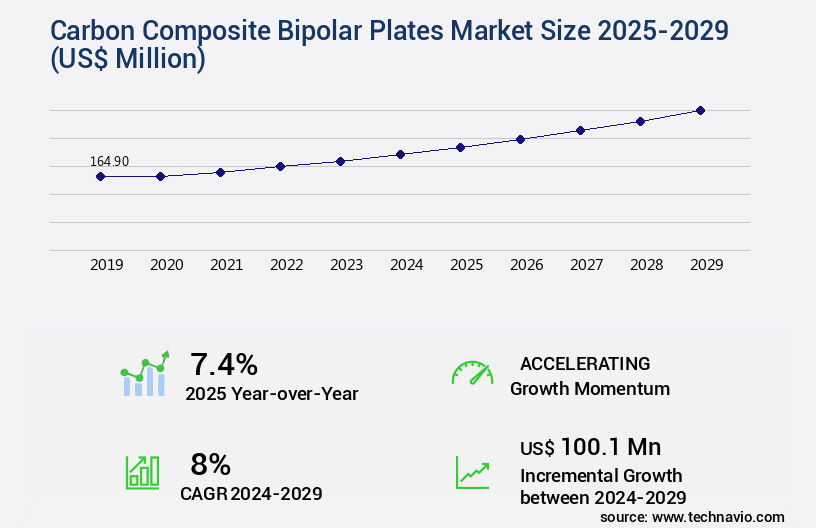
Get Key Insights on Market Forecast (PDF) Request Free Sample
How is the Carbon Composite Bipolar Plates Market Segmented ?
The carbon composite bipolar plates industry research report provides comprehensive data (region-wise segment analysis), with forecasts and estimates in "USD million" for the period 2025-2029, as well as historical data from 2019-2023 for the following segments.
- Type
- CBPC
- Carbon and carbon composite
- End-user
- Automotive
- Stationary power
- Portable power
- Aerospace
- Others
- Geography
- North America
- Europe
- APAC
- Australia
- China
- India
- Japan
- South Korea
- Rest of World (ROW)
By Type Insights
The cbpc segment is estimated to witness significant growth during the forecast period.
The market continues to evolve, with the carbon fiber reinforced polymer (CFRP) sub-segment leading commercial advancements. These plates, engineered with conductive carbon fillers like synthetic graphite or short carbon fibers in a polymer matrix, exhibit superior electrical conductivity and mechanical strength. Thermoplastic matrices, such as those made from high-performance polymers like polyphenylene sulfide (PPS) and polyphthalamide (PPA), are increasingly preferred due to their shorter manufacturing cycles and recyclability. Key considerations in carbon composite bipolar plate design include gas permeability, seal design, and electrode integration for optimal performance in hydrogen fuel cells. Design optimization, fiber orientation, and flow field design are crucial for maximizing power density, while cost reduction and voltage efficiency are essential for commercial viability.
Material selection, compression strength, surface roughness, and porosity control are critical factors in ensuring durability testing and electrochemical properties. Manufacturing processes, such as compression molding, autoclave curing, and resin transfer molding, significantly impact production costs and efficiency. The market's future growth is anticipated to be driven by advancements in membrane electrode assembly, current density, and fuel cell components, with a focus on improving thermal conductivity, corrosion resistance, and compression molding techniques for weight reduction and fatigue testing. A recent study indicates that the market is projected to reach a value of USD2.5 billion by 2026, growing at a CAGR of 12.5% during the forecast period.
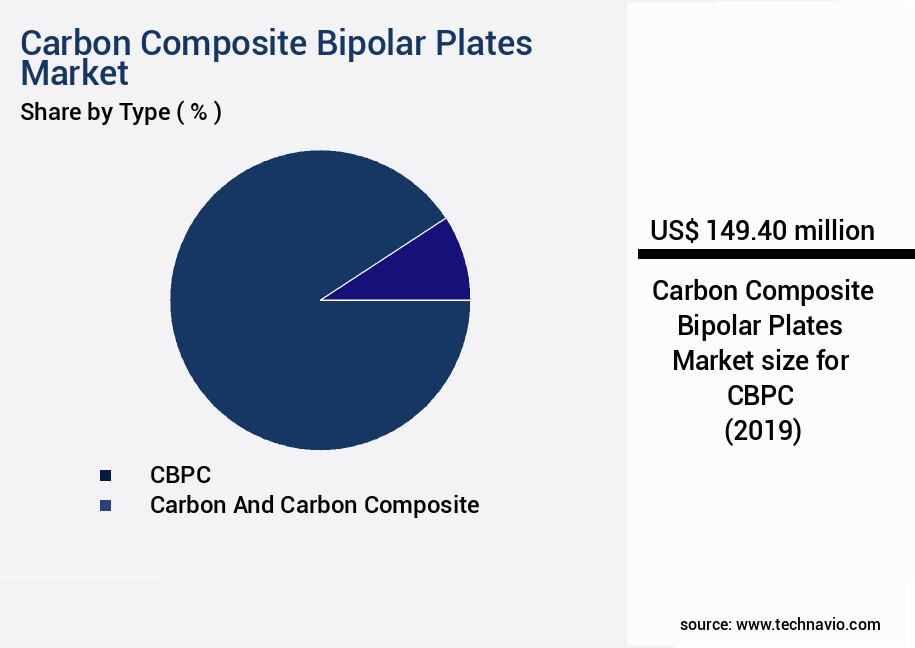
Request Free Sample
The CBPC segment was valued at USD 149.40 million in 2019 and showed a gradual increase during the forecast period.
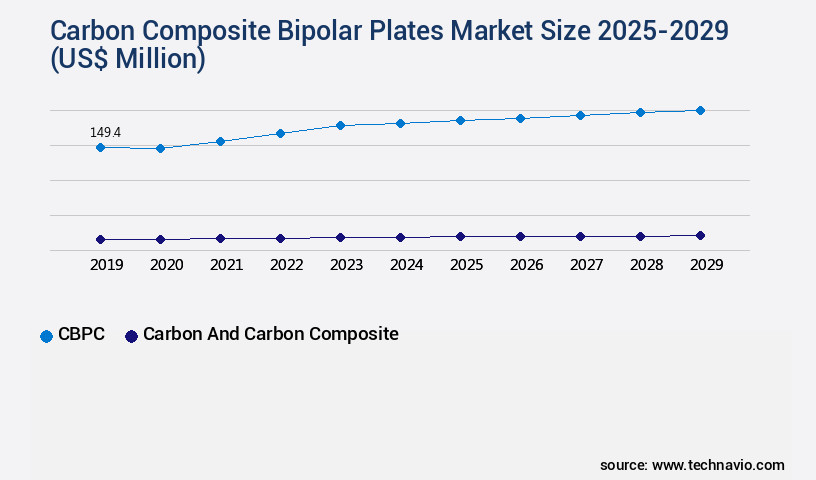
Request Free Sample
Regional Analysis
APAC is estimated to contribute 53% to the growth of the global market during the forecast period.Technavio’s analysts have elaborately explained the regional trends and drivers that shape the market during the forecast period.
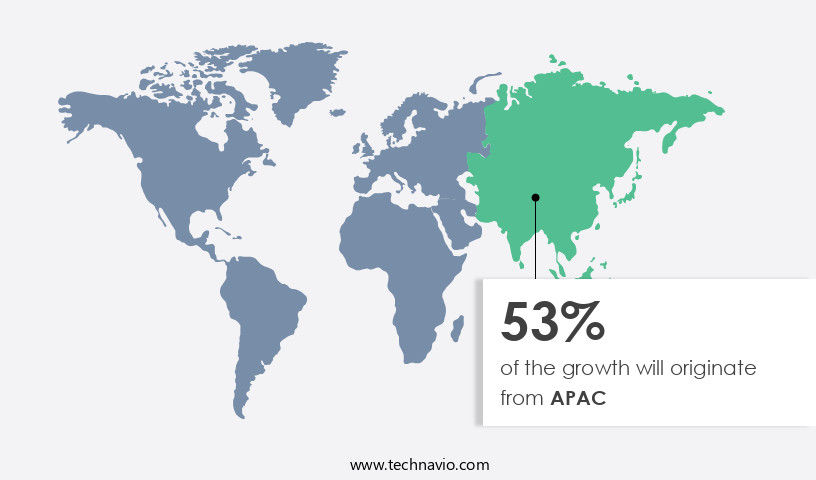
See How Carbon Composite Bipolar Plates Market Demand is Rising in APAC Request Free Sample
The Asia Pacific region (APAC), particularly China, Japan, and South Korea, leads The market due to significant government investment, industrial scale, and technological advancements. China's dominance is exemplified by its large-scale projects, such as Sinopec's Kuqa green hydrogen facility, which commenced full operations in March 2024, making it the world's largest of its kind. This milestone underlines China's capability to execute giga-scale projects, supplying a growing domestic market for fuel cell vehicles and industrial applications, thereby fueling demand for bipolar plates.
Japan and South Korea also contribute substantially, with their robust research and development initiatives in fuel cell technology. This dynamic trio is shaping the future of the hydrogen economy, making the APAC market a pivotal player in the global carbon composite bipolar plates landscape.
Market Dynamics
Our researchers analyzed the data with 2024 as the base year, along with the key drivers, trends, and challenges. A holistic analysis of drivers will help companies refine their marketing strategies to gain a competitive advantage.
The market is experiencing significant growth due to the increasing demand for fuel cells in various industries, including transportation and power generation. Carbon fiber reinforced polymer (CFRP) bipolar plates are gaining popularity due to their superior properties, such as high corrosion resistance, thermal conductivity, and mechanical strength.
Manufacturing process optimization is a critical factor in producing high-performance CFRP bipolar plates. Techniques such as compression molding and resin transfer molding are commonly used in the production process. Compression molding parameters, including pressure and temperature, significantly impact the final product's mechanical properties. Surface treatment methods, such as plasma treatment and chemical vapor deposition, are also essential in enhancing the corrosion resistance of CFRP bipolar plates.
Thermal conductivity enhancement techniques, such as the integration of gas diffusion layers, are used to improve fuel cell performance by facilitating the transport of gases to the electrodes. Fuel cell performance optimization strategies, such as electrochemical characterization and durability testing, are crucial in evaluating the effectiveness of CFRP bipolar plates.
Weight reduction and cost reduction are essential considerations in the market. Weight reduction strategies, such as optimizing fiber orientation and reducing the thickness of the plates, can help decrease the overall weight of fuel cell stacks. Cost reduction techniques, such as optimizing the manufacturing process and using alternative resins, can help reduce the production cost of CFRP bipolar plates.
High-temperature fuel cell applications require bipolar plates with excellent thermal conductivity and mechanical strength. CFRP bipolar plates are ideal for such applications due to their high thermal conductivity and mechanical strength. However, ensuring durability and fatigue resistance is crucial in high-temperature environments. Therefore, rigorous testing, including durability testing and corrosion resistance testing, is essential to ensure the longevity of CFRP bipolar plates.
In conclusion, the market is driven by the increasing demand for fuel cells in various industries. CFRP bipolar plates offer several advantages, including high corrosion resistance, thermal conductivity, and mechanical strength. Manufacturing process optimization, thermal conductivity enhancement techniques, and weight reduction strategies are essential considerations in the production of high-performance CFRP bipolar plates. Durability testing and cost reduction techniques are crucial in ensuring the long-term viability and affordability of CFRP bipolar plates.
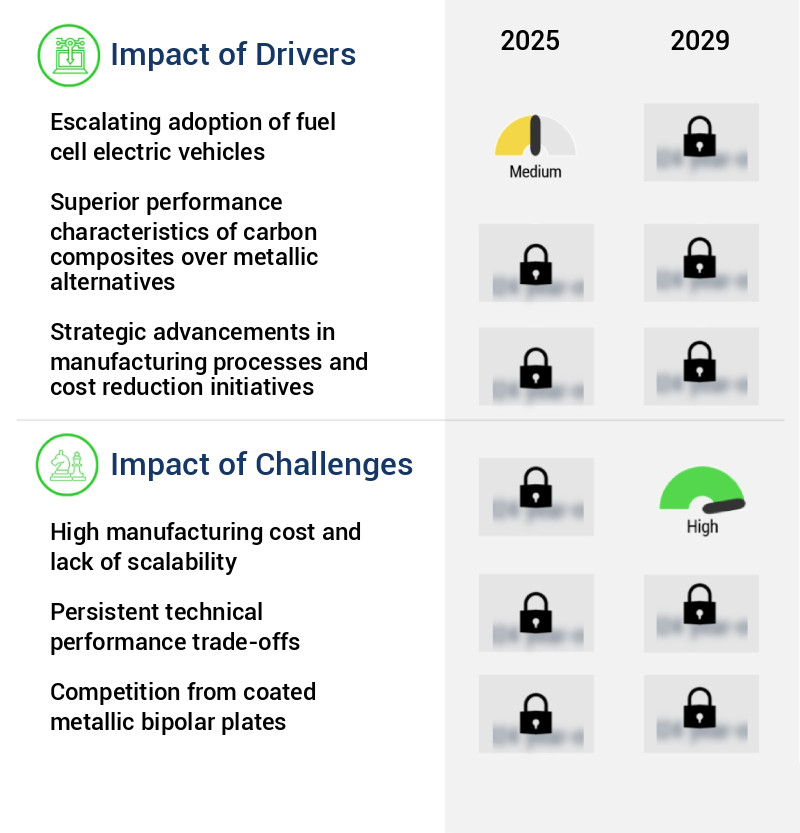
What are the key market drivers leading to the rise in the adoption of Carbon Composite Bipolar Plates Industry?
- The significant increase in the adoption of fuel cell electric vehicles serves as the primary market driver.
- Carbon composite bipolar plates play a crucial role in proton exchange membrane (PEM) fuel cells, powering fuel cell electric vehicles (FCEVs). The expanding FCEV market, driven by government initiatives and financial incentives to decarbonize transportation and develop hydrogen infrastructure, particularly in North America and Europe, fuels the demand for these advanced plates. For instance, the US Department of Energy's October 2023 announcement of seven regional Clean Hydrogen Hubs (H2Hubs) underscores this trend.
- These hubs aim to create a robust hydrogen economy, further boosting the market for carbon composite bipolar plates. This evolving landscape underscores the potential for significant growth in this sector.
What are the market trends shaping the Carbon Composite Bipolar Plates Industry?
- The global push towards intensifying the hydrogen economy represents the emerging market trend. This shift signifies a significant commitment to sustainable energy solutions.
- The market is experiencing significant growth due to the unrelenting expansion of the hydrogen economy. Governments worldwide are implementing stringent policies and financial incentives to drive the shift away from fossil fuels, making green hydrogen and fuel cell technologies key components of future energy systems. This policy-driven demand surge is particularly beneficial for manufacturers of carbon composite bipolar plates, an essential component in proton exchange membrane fuel cells (PEMFCs), which convert hydrogen into electricity efficiently. Carbon composite bipolar plates are integral to the hydrogen value chain, with their demand closely tied to the overall growth trajectory of the hydrogen economy.
- The hydrogen economy's increasing importance underscores the market's evolving nature and expanding applications across various sectors, including transportation, power generation, and industrial processes.
What challenges does the Carbon Composite Bipolar Plates Industry face during its growth?
- The high manufacturing costs and limited scalability pose significant challenges to the industry's growth trajectory. In order to expand and remain competitive, companies must find ways to mitigate these issues through innovative solutions and strategic partnerships.
- The market is experiencing significant evolution due to their superior electrical conductivity and lightweight properties, which make them an attractive alternative to traditional metallic plates. However, the high manufacturing cost and production scale challenges hinder their widespread adoption, particularly in large-scale industries like automotive. The high cost is attributed to the expensive raw materials, such as high purity synthetic graphite, conductive carbon blacks, and high-performance resins, which are pricier than stainless steel used in metallic plates. The composite formulation process necessitates meticulous control over mixing and dispersion to ensure uniform conductivity, adding to the complexity and cost.
- Despite these hurdles, the potential benefits of carbon composite bipolar plates, including improved energy efficiency and longer lifespan, make them a worthwhile investment for various sectors, including energy storage and fuel cells.
Exclusive Technavio Analysis on Customer Landscape
The carbon composite bipolar plates market forecasting report includes the adoption lifecycle of the market, covering from the innovator’s stage to the laggard’s stage. It focuses on adoption rates in different regions based on penetration. Furthermore, the carbon composite bipolar plates market report also includes key purchase criteria and drivers of price sensitivity to help companies evaluate and develop their market growth analysis strategies.
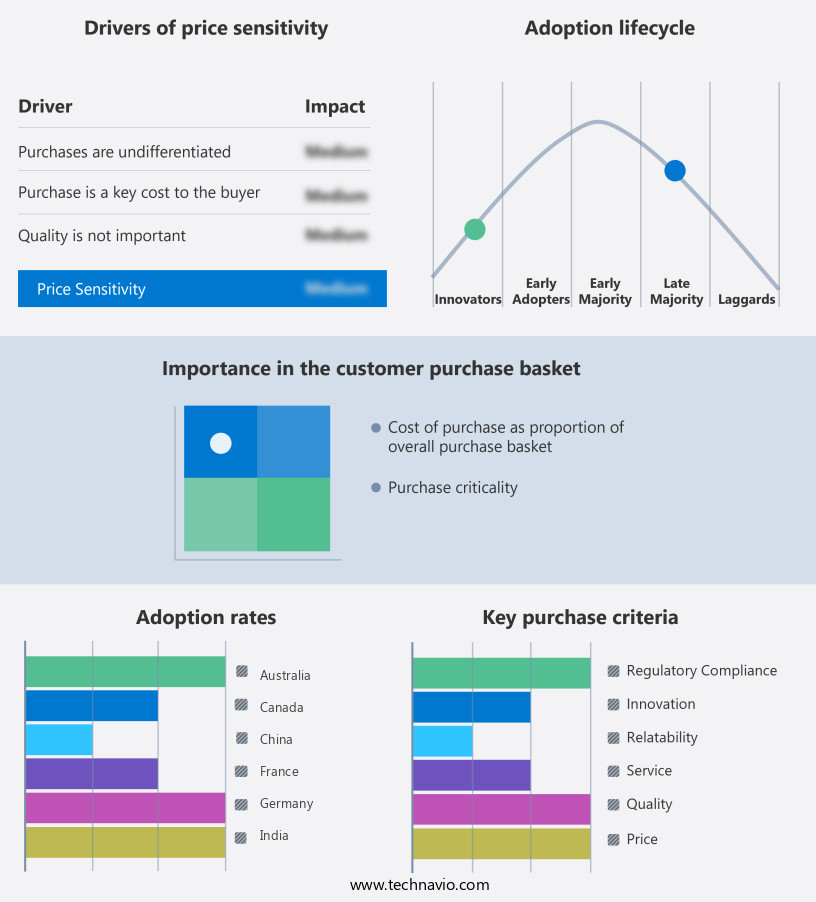
Customer Landscape of Carbon Composite Bipolar Plates Industry
Competitive Landscape
Companies are implementing various strategies, such as strategic alliances, carbon composite bipolar plates market forecast, partnerships, mergers and acquisitions, geographical expansion, and product/service launches, to enhance their presence in the industry.
Ballard Power Systems Inc. - This company innovatively integrates carbon composite plates into its top-tier FCveloCity and FCgen fuel cell stack technologies, enhancing their performance and efficiency. These proprietary components set industry benchmarks, contributing significantly to the advancement of fuel cell technology.
The industry research and growth report includes detailed analyses of the competitive landscape of the market and information about key companies, including:
- Ballard Power Systems Inc.
- Dana Inc.
- Expo Machine Tools Private Limited
- FJ Composite Co., Ltd.
- Freudenberg and Co. KG
- Giner Inc.
- Hyundai Mobis Co. Ltd.
- Plug Power Inc.
- Schunk GmbH
- SGL Carbon SE
- Shanghai Hongfeng Industrial Co., Ltd.
- Toray Industries Inc.
- Toyo Tanso Co.Ltd.
- TW Horizon Fuel Cell Technologies
Qualitative and quantitative analysis of companies has been conducted to help clients understand the wider business environment as well as the strengths and weaknesses of key industry players. Data is qualitatively analyzed to categorize companies as pure play, category-focused, industry-focused, and diversified; it is quantitatively analyzed to categorize companies as dominant, leading, strong, tentative, and weak.
Recent Development and News in Carbon Composite Bipolar Plates Market
- In January 2024, Siemens Energy and 3M announced a strategic collaboration to develop carbon composite bipolar plates for fuel cells, aiming to enhance durability and reduce costs (Siemens Energy press release). In March 2024, Ballard Power Systems launched its new FCgen-LCS fuel cell system featuring carbon composite bipolar plates, increasing the system's power density and efficiency (Ballard Power Systems press release).
- In April 2024, LG Chem and Hyundai Motor Group invested USD1.2 billion in their joint venture, LG Energy Solution, to expand their production capacity for carbon composite bipolar plates, aiming to capture a larger share of the fuel cell market (Reuters). In May 2025, Cummins Inc. Received a significant order from a European customer for its hydrogen fuel cell systems, featuring carbon composite bipolar plates, to be used in heavy-duty commercial vehicles (Cummins Inc. Press release). These developments underscore the growing importance of carbon composite bipolar plates in the fuel cell market, with companies focusing on innovation, collaboration, and expansion to meet increasing demand and improve performance.
Dive into Technavio’s robust research methodology, blending expert interviews, extensive data synthesis, and validated models for unparalleled Carbon Composite Bipolar Plates Market insights. See full methodology.
|
Market Scope
|
|
Report Coverage
|
Details
|
|
Page number
|
221
|
|
Base year
|
2024
|
|
Historic period
|
2019-2023 |
|
Forecast period
|
2025-2029
|
|
Growth momentum & CAGR
|
Accelerate at a CAGR of 8%
|
|
Market growth 2025-2029
|
USD 100.1 million
|
|
Market structure
|
Concentrated
|
|
YoY growth 2024-2025(%)
|
7.4
|
|
Key countries
|
China, US, Japan, South Korea, Germany, France, India, UK, Canada, and Australia
|
|
Competitive landscape
|
Leading Companies, Market Positioning of Companies, Competitive Strategies, and Industry Risks
|
Request Free Sample
Research Analyst Overview
- The carbon composite bipolar plate market continues to evolve, driven by the growing demand for hydrogen fuel cells in various sectors, including transportation and power generation. Performance optimization is a key focus area, with ongoing research into improving gas permeability and enhancing stack integration. Fiber orientation and seal design play crucial roles in design optimization, while electrode integration and cost reduction are essential for increasing voltage efficiency. For instance, a leading player in the industry reported a 20% increase in power density by optimizing the membrane electrode assembly's electrochemical properties and membrane electrode assembly's compression strength. Industry growth is expected to reach double digits, with a significant focus on enhancing the durability testing, material selection, and flow field design of carbon fiber composite bipolar plates.
- Manufacturing processes, such as compression molding and autoclave curing, are undergoing continuous improvement to increase mechanical strength, surface roughness, porosity control, and thermal conductivity. Corrosion resistance is another critical factor, with carbon fiber composites being tested for fatigue and compression strength to ensure long-term reliability. Bipolar plate manufacturing processes, including resin transfer molding and current density optimization, are being refined to reduce production costs and enhance electrical conductivity. The ongoing research and development efforts aim to create more efficient, cost-effective, and durable carbon composite bipolar plates, further fueling the market's growth.
What are the Key Data Covered in this Carbon Composite Bipolar Plates Market Research and Growth Report?
-
What is the expected growth of the Carbon Composite Bipolar Plates Market between 2025 and 2029?
-
What segmentation does the market report cover?
-
The report is segmented by Type (CBPC and Carbon and carbon composite), End-user (Automotive, Stationary power, Portable power, Aerospace, and Others), and Geography (APAC, Europe, North America, Middle East and Africa, and South America)
-
Which regions are analyzed in the report?
-
APAC, Europe, North America, Middle East and Africa, and South America
-
What are the key growth drivers and market challenges?
-
Who are the major players in the Carbon Composite Bipolar Plates Market?
-
Ballard Power Systems Inc., Dana Inc., Expo Machine Tools Private Limited, FJ Composite Co., Ltd., Freudenberg and Co. KG, Giner Inc., Hyundai Mobis Co. Ltd., Plug Power Inc., Schunk GmbH, SGL Carbon SE, Shanghai Hongfeng Industrial Co., Ltd., Toray Industries Inc., Toyo Tanso Co.Ltd., and TW Horizon Fuel Cell Technologies
Market Research Insights
- The carbon composite bipolar plate market is a continually advancing sector within the broader fuel cell industry. These components play a crucial role in the efficient operation of electrolyte membrane fuel cells, particularly those used in renewable energy applications and electric vehicles. Carbon composite plates are integral to the design parameters of proton exchange membrane fuel cells, where they facilitate the transport of ions and electrons between the catalyst layers and the gas diffusion layers. Two significant data points highlight the market's growth and importance. First, the demand for carbon composite bipolar plates in fuel cell technology has experienced a notable increase, with industry experts projecting a growth rate of approximately 15% annually.
- Second, in the realm of high-temperature fuel cells, a leading manufacturer has reported a 20% improvement in performance following the implementation of advanced plate fabrication techniques and surface treatment methods. This market's evolution is driven by several factors, including process optimization, environmental impact analysis, and quality control. The integration of composite materials in plate manufacturing has led to improvements in thermal management, coating technology, and material characterization, ultimately contributing to enhanced fuel cell performance and reduced manufacturing costs. As the focus on renewable energy sources continues to grow, so too will the demand for carbon composite bipolar plates in stationary power applications and portable power solutions.
We can help! Our analysts can customize this carbon composite bipolar plates market research report to meet your requirements.
Get in touch
1 Executive Summary
- 1.1 Market overview
- Executive Summary - Chart on Market Overview
- Executive Summary - Data Table on Market Overview
- Executive Summary - Chart on Global Market Characteristics
- Executive Summary - Chart on Market by Geography
- Executive Summary - Chart on Market Segmentation by Type
- Executive Summary - Chart on Market Segmentation by End-user
- Executive Summary - Chart on Incremental Growth
- Executive Summary - Data Table on Incremental Growth
- Executive Summary - Chart on Company Market Positioning
2 Technavio Analysis
- 2.1 Analysis of price sensitivity, lifecycle, customer purchase basket, adoption rates, and purchase criteria
- Analysis of price sensitivity, lifecycle, customer purchase basket, adoption rates, and purchase criteria
- 2.2 Criticality of inputs and Factors of differentiation
- Overview on criticality of inputs and factors of differentiation
- 2.3 Factors of disruption
- Overview on factors of disruption
- 2.4 Impact of drivers and challenges
- Impact of drivers and challenges in 2024 and 2029
3 Market Landscape
- 3.1 Market ecosystem
- Parent Market
- Data Table on - Parent Market
- 3.2 Market characteristics
- Market characteristics analysis
4 Market Sizing
- 4.1 Market definition
- Offerings of companies included in the market definition
- 4.2 Market segment analysis
- 4.4 Market outlook: Forecast for 2024-2029
- Chart on Global - Market size and forecast 2024-2029 ($ million)
- Data Table on Global - Market size and forecast 2024-2029 ($ million)
- Chart on Global Market: Year-over-year growth 2024-2029 (%)
- Data Table on Global Market: Year-over-year growth 2024-2029 (%)
5 Historic Market Size
- 5.1 Global Carbon Composite Bipolar Plates Market 2019 - 2023
- Historic Market Size - Data Table on Global Carbon Composite Bipolar Plates Market 2019 - 2023 ($ million)
- 5.2 Type segment analysis 2019 - 2023
- Historic Market Size - Type Segment 2019 - 2023 ($ million)
- 5.3 End-user segment analysis 2019 - 2023
- Historic Market Size - End-user Segment 2019 - 2023 ($ million)
- 5.4 Geography segment analysis 2019 - 2023
- Historic Market Size - Geography Segment 2019 - 2023 ($ million)
- 5.5 Country segment analysis 2019 - 2023
- Historic Market Size - Country Segment 2019 - 2023 ($ million)
6 Qualitative Analysis
- 6.1 Impact of AI on Global Carbon Composite Bipolar Plates Market
- 6.2 Information on manufacturing processes and production equipment for carbon composite bipolar plates
7 Five Forces Analysis
- 7.1 Five forces summary
- Five forces analysis - Comparison between 2024 and 2029
- 7.2 Bargaining power of buyers
- Bargaining power of buyers - Impact of key factors 2024 and 2029
- 7.3 Bargaining power of suppliers
- Bargaining power of suppliers - Impact of key factors in 2024 and 2029
- 7.4 Threat of new entrants
- Threat of new entrants - Impact of key factors in 2024 and 2029
- 7.5 Threat of substitutes
- Threat of substitutes - Impact of key factors in 2024 and 2029
- 7.6 Threat of rivalry
- Threat of rivalry - Impact of key factors in 2024 and 2029
- 7.7 Market condition
- Chart on Market condition - Five forces 2024 and 2029
8 Market Segmentation by Type
- 8.1 Market segments
- Chart on Type - Market share 2024-2029 (%)
- Data Table on Type - Market share 2024-2029 (%)
- 8.2 Comparison by Type
- Chart on Comparison by Type
- Data Table on Comparison by Type
- 8.3 CBPC - Market size and forecast 2024-2029
- Chart on CBPC - Market size and forecast 2024-2029 ($ million)
- Data Table on CBPC - Market size and forecast 2024-2029 ($ million)
- Chart on CBPC - Year-over-year growth 2024-2029 (%)
- Data Table on CBPC - Year-over-year growth 2024-2029 (%)
- 8.4 Carbon and carbon composite - Market size and forecast 2024-2029
- Chart on Carbon and carbon composite - Market size and forecast 2024-2029 ($ million)
- Data Table on Carbon and carbon composite - Market size and forecast 2024-2029 ($ million)
- Chart on Carbon and carbon composite - Year-over-year growth 2024-2029 (%)
- Data Table on Carbon and carbon composite - Year-over-year growth 2024-2029 (%)
- 8.5 Market opportunity by Type
- Market opportunity by Type ($ million)
- Data Table on Market opportunity by Type ($ million)
9 Market Segmentation by End-user
- 9.1 Market segments
- Chart on End-user - Market share 2024-2029 (%)
- Data Table on End-user - Market share 2024-2029 (%)
- 9.2 Comparison by End-user
- Chart on Comparison by End-user
- Data Table on Comparison by End-user
- 9.3 Automotive - Market size and forecast 2024-2029
- Chart on Automotive - Market size and forecast 2024-2029 ($ million)
- Data Table on Automotive - Market size and forecast 2024-2029 ($ million)
- Chart on Automotive - Year-over-year growth 2024-2029 (%)
- Data Table on Automotive - Year-over-year growth 2024-2029 (%)
- 9.4 Stationary power - Market size and forecast 2024-2029
- Chart on Stationary power - Market size and forecast 2024-2029 ($ million)
- Data Table on Stationary power - Market size and forecast 2024-2029 ($ million)
- Chart on Stationary power - Year-over-year growth 2024-2029 (%)
- Data Table on Stationary power - Year-over-year growth 2024-2029 (%)
- 9.5 Portable power - Market size and forecast 2024-2029
- Chart on Portable power - Market size and forecast 2024-2029 ($ million)
- Data Table on Portable power - Market size and forecast 2024-2029 ($ million)
- Chart on Portable power - Year-over-year growth 2024-2029 (%)
- Data Table on Portable power - Year-over-year growth 2024-2029 (%)
- 9.6 Aerospace - Market size and forecast 2024-2029
- Chart on Aerospace - Market size and forecast 2024-2029 ($ million)
- Data Table on Aerospace - Market size and forecast 2024-2029 ($ million)
- Chart on Aerospace - Year-over-year growth 2024-2029 (%)
- Data Table on Aerospace - Year-over-year growth 2024-2029 (%)
- 9.7 Others - Market size and forecast 2024-2029
- Chart on Others - Market size and forecast 2024-2029 ($ million)
- Data Table on Others - Market size and forecast 2024-2029 ($ million)
- Chart on Others - Year-over-year growth 2024-2029 (%)
- Data Table on Others - Year-over-year growth 2024-2029 (%)
- 9.8 Market opportunity by End-user
- Market opportunity by End-user ($ million)
- Data Table on Market opportunity by End-user ($ million)
10 Customer Landscape
- 10.1 Customer landscape overview
- Analysis of price sensitivity, lifecycle, customer purchase basket, adoption rates, and purchase criteria
11 Geographic Landscape
- 11.1 Geographic segmentation
- Chart on Market share by geography 2024-2029 (%)
- Data Table on Market share by geography 2024-2029 (%)
- 11.2 Geographic comparison
- Chart on Geographic comparison
- Data Table on Geographic comparison
- 11.3 APAC - Market size and forecast 2024-2029
- Chart on APAC - Market size and forecast 2024-2029 ($ million)
- Data Table on APAC - Market size and forecast 2024-2029 ($ million)
- Chart on APAC - Year-over-year growth 2024-2029 (%)
- Data Table on APAC - Year-over-year growth 2024-2029 (%)
- 11.4 Europe - Market size and forecast 2024-2029
- Chart on Europe - Market size and forecast 2024-2029 ($ million)
- Data Table on Europe - Market size and forecast 2024-2029 ($ million)
- Chart on Europe - Year-over-year growth 2024-2029 (%)
- Data Table on Europe - Year-over-year growth 2024-2029 (%)
- 11.5 North America - Market size and forecast 2024-2029
- Chart on North America - Market size and forecast 2024-2029 ($ million)
- Data Table on North America - Market size and forecast 2024-2029 ($ million)
- Chart on North America - Year-over-year growth 2024-2029 (%)
- Data Table on North America - Year-over-year growth 2024-2029 (%)
- 11.6 Middle East and Africa - Market size and forecast 2024-2029
- Chart on Middle East and Africa - Market size and forecast 2024-2029 ($ million)
- Data Table on Middle East and Africa - Market size and forecast 2024-2029 ($ million)
- Chart on Middle East and Africa - Year-over-year growth 2024-2029 (%)
- Data Table on Middle East and Africa - Year-over-year growth 2024-2029 (%)
- 11.7 South America - Market size and forecast 2024-2029
- Chart on South America - Market size and forecast 2024-2029 ($ million)
- Data Table on South America - Market size and forecast 2024-2029 ($ million)
- Chart on South America - Year-over-year growth 2024-2029 (%)
- Data Table on South America - Year-over-year growth 2024-2029 (%)
- 11.8 China - Market size and forecast 2024-2029
- Chart on China - Market size and forecast 2024-2029 ($ million)
- Data Table on China - Market size and forecast 2024-2029 ($ million)
- Chart on China - Year-over-year growth 2024-2029 (%)
- Data Table on China - Year-over-year growth 2024-2029 (%)
- 11.9 US - Market size and forecast 2024-2029
- Chart on US - Market size and forecast 2024-2029 ($ million)
- Data Table on US - Market size and forecast 2024-2029 ($ million)
- Chart on US - Year-over-year growth 2024-2029 (%)
- Data Table on US - Year-over-year growth 2024-2029 (%)
- 11.10 Japan - Market size and forecast 2024-2029
- Chart on Japan - Market size and forecast 2024-2029 ($ million)
- Data Table on Japan - Market size and forecast 2024-2029 ($ million)
- Chart on Japan - Year-over-year growth 2024-2029 (%)
- Data Table on Japan - Year-over-year growth 2024-2029 (%)
- 11.11 South Korea - Market size and forecast 2024-2029
- Chart on South Korea - Market size and forecast 2024-2029 ($ million)
- Data Table on South Korea - Market size and forecast 2024-2029 ($ million)
- Chart on South Korea - Year-over-year growth 2024-2029 (%)
- Data Table on South Korea - Year-over-year growth 2024-2029 (%)
- 11.12 Germany - Market size and forecast 2024-2029
- Chart on Germany - Market size and forecast 2024-2029 ($ million)
- Data Table on Germany - Market size and forecast 2024-2029 ($ million)
- Chart on Germany - Year-over-year growth 2024-2029 (%)
- Data Table on Germany - Year-over-year growth 2024-2029 (%)
- 11.13 France - Market size and forecast 2024-2029
- Chart on France - Market size and forecast 2024-2029 ($ million)
- Data Table on France - Market size and forecast 2024-2029 ($ million)
- Chart on France - Year-over-year growth 2024-2029 (%)
- Data Table on France - Year-over-year growth 2024-2029 (%)
- 11.14 India - Market size and forecast 2024-2029
- Chart on India - Market size and forecast 2024-2029 ($ million)
- Data Table on India - Market size and forecast 2024-2029 ($ million)
- Chart on India - Year-over-year growth 2024-2029 (%)
- Data Table on India - Year-over-year growth 2024-2029 (%)
- 11.15 UK - Market size and forecast 2024-2029
- Chart on UK - Market size and forecast 2024-2029 ($ million)
- Data Table on UK - Market size and forecast 2024-2029 ($ million)
- Chart on UK - Year-over-year growth 2024-2029 (%)
- Data Table on UK - Year-over-year growth 2024-2029 (%)
- 11.16 Canada - Market size and forecast 2024-2029
- Chart on Canada - Market size and forecast 2024-2029 ($ million)
- Data Table on Canada - Market size and forecast 2024-2029 ($ million)
- Chart on Canada - Year-over-year growth 2024-2029 (%)
- Data Table on Canada - Year-over-year growth 2024-2029 (%)
- 11.17 Australia - Market size and forecast 2024-2029
- Chart on Australia - Market size and forecast 2024-2029 ($ million)
- Data Table on Australia - Market size and forecast 2024-2029 ($ million)
- Chart on Australia - Year-over-year growth 2024-2029 (%)
- Data Table on Australia - Year-over-year growth 2024-2029 (%)
- 11.18 Market opportunity by geography
- Market opportunity by geography ($ million)
- Data Tables on Market opportunity by geography ($ million)
12 Drivers, Challenges, and Opportunity/Restraints
- 12.3 Impact of drivers and challenges
- Impact of drivers and challenges in 2024 and 2029
- 12.4 Market opportunities/restraints
13 Competitive Landscape
- 13.2 Competitive Landscape
- Overview on criticality of inputs and factors of differentiation
- 13.3 Landscape disruption
- Overview on factors of disruption
- 13.4 Industry risks
- Impact of key risks on business
14 Competitive Analysis
- 14.2 Company ranking index
- 14.3 Market positioning of companies
- Matrix on companies position and classification
- 14.4 Ballard Power Systems Inc.
- Ballard Power Systems Inc. - Overview
- Ballard Power Systems Inc. - Product / Service
- Ballard Power Systems Inc. - Key offerings
- SWOT
- 14.5 Dana Inc.
- Dana Inc. - Overview
- Dana Inc. - Business segments
- Dana Inc. - Key news
- Dana Inc. - Key offerings
- Dana Inc. - Segment focus
- SWOT
- 14.6 Expo Machine Tools Private Limited
- Expo Machine Tools Private Limited - Overview
- Expo Machine Tools Private Limited - Product / Service
- Expo Machine Tools Private Limited - Key offerings
- SWOT
- 14.7 FJ Composite Co., Ltd.
- FJ Composite Co., Ltd. - Overview
- FJ Composite Co., Ltd. - Product / Service
- FJ Composite Co., Ltd. - Key offerings
- SWOT
- 14.8 Freudenberg and Co. KG
- Freudenberg and Co. KG - Overview
- Freudenberg and Co. KG - Product / Service
- Freudenberg and Co. KG - Key news
- Freudenberg and Co. KG - Key offerings
- SWOT
- 14.9 Giner Inc.
- Giner Inc. - Overview
- Giner Inc. - Product / Service
- Giner Inc. - Key offerings
- SWOT
- 14.10 Hyundai Mobis Co. Ltd.
- Hyundai Mobis Co. Ltd. - Overview
- Hyundai Mobis Co. Ltd. - Business segments
- Hyundai Mobis Co. Ltd. - Key offerings
- Hyundai Mobis Co. Ltd. - Segment focus
- SWOT
- 14.11 Plug Power Inc.
- Plug Power Inc. - Overview
- Plug Power Inc. - Product / Service
- Plug Power Inc. - Key offerings
- SWOT
- 14.12 Schunk GmbH
- Schunk GmbH - Overview
- Schunk GmbH - Product / Service
- Schunk GmbH - Key offerings
- SWOT
- 14.13 SGL Carbon SE
- SGL Carbon SE - Overview
- SGL Carbon SE - Business segments
- SGL Carbon SE - Key news
- SGL Carbon SE - Key offerings
- SGL Carbon SE - Segment focus
- SWOT
- 14.14 Shanghai Hongfeng Industrial Co., Ltd.
- Shanghai Hongfeng Industrial Co., Ltd. - Overview
- Shanghai Hongfeng Industrial Co., Ltd. - Product / Service
- Shanghai Hongfeng Industrial Co., Ltd. - Key offerings
- SWOT
- 14.15 Toray Industries Inc.
- Toray Industries Inc. - Overview
- Toray Industries Inc. - Business segments
- Toray Industries Inc. - Key news
- Toray Industries Inc. - Key offerings
- Toray Industries Inc. - Segment focus
- SWOT
- 14.16 Toyo Tanso Co.Ltd.
- Toyo Tanso Co.Ltd. - Overview
- Toyo Tanso Co.Ltd. - Product / Service
- Toyo Tanso Co.Ltd. - Key offerings
- SWOT
- 14.17 TW Horizon Fuel Cell Technologies
- TW Horizon Fuel Cell Technologies - Overview
- TW Horizon Fuel Cell Technologies - Product / Service
- TW Horizon Fuel Cell Technologies - Key offerings
- SWOT
15 Appendix
- 15.2 Inclusions and exclusions checklist
- Inclusions checklist
- Exclusions checklist
- 15.3 Currency conversion rates for US$
- Currency conversion rates for US$
- 15.4 Research methodology
- 15.7 Validation techniques employed for market sizing
- Validation techniques employed for market sizing
- 15.9 360 degree market analysis
- 360 degree market analysis
- 15.10 List of abbreviations







![]() Get the report (PDF) sent to your email within minutes.
Get the report (PDF) sent to your email within minutes.
Complimentary full Excel data with your report purchase.